sensor AUDI Q3 2016 Owner's Manual
[x] Cancel search | Manufacturer: AUDI, Model Year: 2016, Model line: Q3, Model: AUDI Q3 2016Pages: 252, PDF Size: 62.81 MB
Page 124 of 252

Airbag syste m
-Never place or attach accessories or other
objects (such as cupholders, telephone
brackets, large, heavy or bulky objects) on
the doors, over or near the area marked "AIRBAG" on the steering wheel, instru
ment panel, seat backrests or between
those areas and yourself. These objects
could cause injury in a crash, especially
when the airbags inflate.
- Never recline the front passenger's seat to
transport objec ts. Items can also move into
the area of the side airbag or the front a ir
bag dur ing braking or in a sudden maneu
ver. Objects near the airbags can become projectiles and cause injury, particularly
when the seat is reclined.
A WARNING
The f ine dust created when airbags deploy can
cause breath ing problems for people w ith a
history of asthma or other breathing condi
t ions.
- To reduce the risk of breathing problems,
those w ith asthma or other respiratory con
ditions should get fresh air right away by
gett ing out of the vehicle o r opening w in
dows or doors.
- If you are in a collision in which airbags de
ploy, wash your hands and fa ce with mild
soap and water befo re eat ing.
- Be careful not to get the dust into your eyes,
o r into any cu ts or sc ratches.
- If the resid ue should get into yo ur eyes,
flush them with water.
Monitoring the
Advanced Airbag System
!f Airbag monitoring indicator light
Two separate indicators monitor the function of
the Advanced Airbag System: the airbag moni
toring indicator light and the
PA SSENGER AIR
BAG OFF
light.
The Advanced Airbag System as well as the side airbags and side curtain airbags with eject ion
mit igat ion features ( including the electronic con
trol unit, sensors and system wiring) are all
122
monitored continuous ly to make sure that they
are functioning properly whenever the ignition is
on . Each time you turn on the ignit ion, the airbag
monitoring indicator light
m will come on for a
few seconds (se lf diagnostics) .
The system mu st be inspected wh en th e
indicat or light
E,I:
- does not come on when the ignition is switched
on,
- does not go out a few seconds after you have
switched on the ignit ion, or
- comes on while driving.
If an airbag system malfunc tion is detec ted, the
indicator light will first start flashing to catch the
driver's attention and then stay on continuously
to serve as a constant rem inder to have the sys
tem inspected immediately.
If a malfunction occurs that turns the front air
bag on the passenger side off, the
PASSENGER
AIR BAG O FF
light will come on and stay on
whenever the ignition is on.
A WARNING
An airbag system that is not functioning prop
erly cannot provide supplemental protect ion
in a frontal crash .
- If the airbag ind icator light
q page 16
comes when the veh icle is being used, have
the system inspected immediately by your
author ized Audi dealer. It is possib le that
the airbag will i nfla te when i t is no t sup
posed to, or wi ll not inf late when it sho uld.
PASSENGER AIR BAG OFF light
Fig. 12 4 Section from the inst rument panel: PASSENGER
&l N 9 ::::, CD m
AIR BAG OFF l ight ...
Page 125 of 252

The PASSENGER AIR BAG O FF light is located in
the c enter of the instrument panel¢
fig. 124 .
The PASS ENGER AIR BAG OFF light will come on
and stay on to tell you when the front Advanced
Airbag on the passenger side has been turned off
by the el ectronic control unit . Each time you turn
on the ignition, the
P ASSENGER AIR BAG OFF
light will flash for a few seconds and:
- will stay on if the front passenger seat is not
occupied,
- will stay on if the re is a sma ll child or child re
straint on the front passenger seat,
- wi ll go out if the front passenge r seat is occu
pied by an adult as registered by the weight
sensing mat .
The
PA SSENGER AIR BAG O FF light mu st c ome
on and sta y on
if the igni tion is on and
- a car bed has been insta lled on the front seat,
o r
- a rearward-facing child restrai nt has been in
stalled on the front passenger seat , or
- a forward -facing child restra int has been instal
led on the front passenger seat, or
- the weight reg istered on the front passenger
seat is equal to or less than the comb ined
weight of a typical 1 yea r-o ld restrained in one
of the rear-facing or forward-fac ing infant re
strain ts listed in Federal Motor Vehicle Safety
Standard 208 w ith which the Advanced A irbag
System in your vehicle was certified.
I f the front passenger seat is no t occupied, the
fron t air bag w ill not deploy, and the
PASSENGER
AIR BAG OFF
light will stay on . Never install a
rearward -fac ing child restraint on the front pas
senger s eat, the safest p lace for a child in any
kind of child restraint is at one of the seating po
sitions on the rear seat ¢
page 113, Child re
s train ts on the front sea t-some impor tan t
things to know
and ¢ page 132, Child safety .
If the PASSENGER AIR BAG OFF light comes on
when one of the conditions listed above is met,
be sure to check the light regularly to make cer
tain that the
PASSENGER AIR BA G OFF light
stays on cont inuously whenever the ign ition is
on . If the
PASSENGER A IR BAG OFF lig ht does
Airb ag sys tem
not appear and not stay on all the time, stop as
soon as it is safe to do so and
- react ivate the system by tur ning t he ignit ion
off and then t urn ing it on again ;
- remove and re insta ll the chi ld restrain t. M ake
sure that the chi ld restraint is properly ins ta l
led and that the safety belt for the front pas
senger seat has bee n correct ly routed around
the child restraint as desc ribed in the c hild re
straint manufacture r's instruct ions;
- make sure that the convertible locking retrac
tor on the safety belt for the front passenge r
seat has been activated and that the safety belt
has been pulled tight. The belt must not be
loose or have loops of slack so that the sensor
below the safety belt latch on the seat can do
its job ¢
page 141 .
-make sure that th ings that may increase the
weight of the child and ch ild safety seat are not
be ing transported on the front passenger seat ;
- make sure that the safety belt tens ion sensor is
not b locked . Shake the safety belt la tch on the
front passenger seatback and fo rth ;
- If a strap or tether is being used to tie the child
safety seat to the front passenger seat, make
sure that it is not so tight t hat i t causes the
weight-sensing mat to me asu re more weight
than is actua lly on the sea t.
If the PASSENGER AIR BAG OFF light still do es
not come on
and does not stay on co nti nuously
(whe n the ignition is switched on),
- take the child restraint off the front passenge r
seat and install it p roper ly at one of the rear
seat pos itions . Have the airbag system inspect
ed by yo ur au thori zed Audi deale r immedi ately .
- move the child to a rear seat pos ition and ma ke
sure that t he chi ld is proper ly rest rained in a
child restra int that is appropr iate for its s ize
and age .
T he
PASSENGER AIR BAG OFF lig ht should NOT
come on when the ignit io n is on and an adu lt is
s itting in a prope r seat ing pos ition on the front
passenge r seat. If the
PASSENGER AIR BAG OFF
light comes on and stays on or flashes for about
5 seconds whi le dr iv ing, under these c ircumstan-
ces, make sure that :
Ill-
123
Page 128 of 252
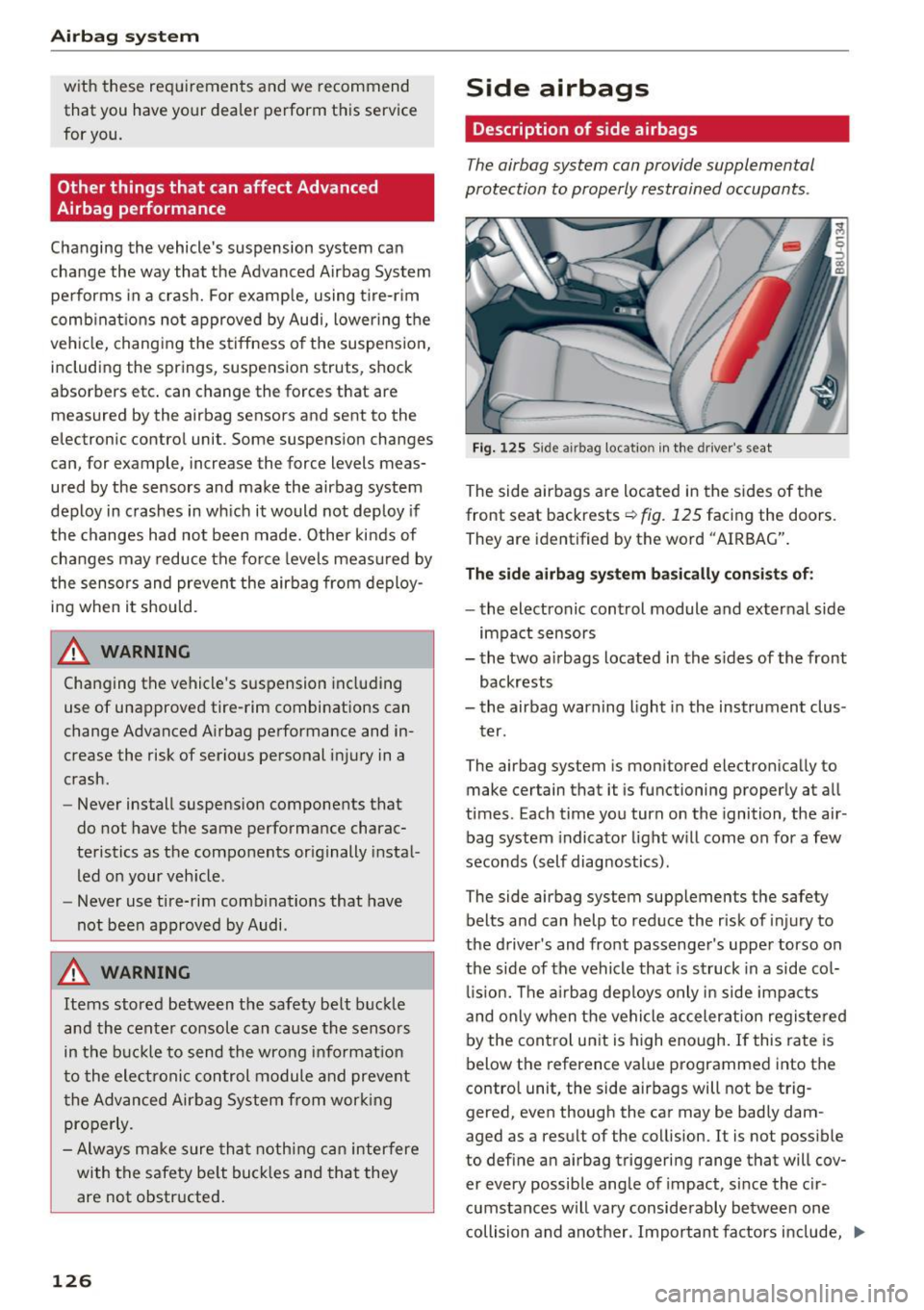
Airbag syste m
with these requirements and we recommend
that you have your dealer perform this service
for you.
Other things that can affect Advanced
Airbag performance
Changing the vehicle's suspension system can
change the way that the Advanced Airbag System
performs in a crash. For examp le, using t ire-r im
comb inat ions not approved by Audi, lower ing the
veh icle, changing the stiffness of the suspens ion,
including the springs, suspension struts, shock
absorbers etc . can change the forces that are
measured by the airbag sensors and sent to the
electronic control unit. Some suspension changes
can, for example, increase the force levels meas
ured by the sensors and make the airbag system
deploy in crashes in wh ich it would not deploy if
the changes had not been made. Other kinds of
changes may reduce the force levels meas ured by
the sensors and prevent the airbag from deploy ing when it should.
A WARNING
Changing the vehicle's suspension including
use of unapproved tire-rim combinations can
change Advanced Airbag performance and in
crease the risk of serious personal injury in a
crash.
- Never install suspension components that
do not have the same performance charac
teristics as the components originally instal
led o n your veh icle .
- Never use tire-rim comb inations that have
not been approved by Audi.
A WARNING
Items stored between the safety belt buckle
and the center console can cause the senso rs
in the buckle to send the wrong info rmation
to the electronic control module and prevent
t he Advanced Airbag System from wor king
properly.
- Always make sure tha t noth ing can interfere
with the safety be lt buck les and that they
are not obstructed.
126
Side airbags
Description of side airbags
The airbag system can provide supplemental
protection to properly restrained occupants .
Fig. 125 S ide a irbag locat io n in the driver's seat
The side airbags are located in the sides of the
front seat backrests ¢
fig. 125 facing the doors.
They are identified by the word "AIRBAG".
The sid e airbag system ba sically con sis t s o f:
- the electronic control module and external side
impact sensors
- the two a irbags located in the s ides of the front
backrests
- the airbag warning light in the instrument clus -
ter.
The airbag system is monitored electronica lly to
make certain that it is functioning properly at a ll
t imes. Each time you turn on the ignition, the air
bag system indicator light w ill come on for a few
seconds (self diagnostics) .
The side airbag system supplements the safety belts and can help to reduce the risk of injury to
the driver's and front passenger's upper torso on
the side of the vehicle that is struck in a side co l
li sion. The a irbag deploys only in side impacts
and only when the vehicle acceleration registered by the control unit is high enough. If this rate is
below the reference val ue programmed into the
contro l unit, the side airbags will not be trig-
gered, even though the car may be badly dam-
aged as a result of the collision. It is not possible
to define an airbag triggering range that will cov er every possible angle of impact, si nce the c ir
cumstances w ill vary conside rably between one
collision and another . Important factors include, .,,.
Page 129 of 252
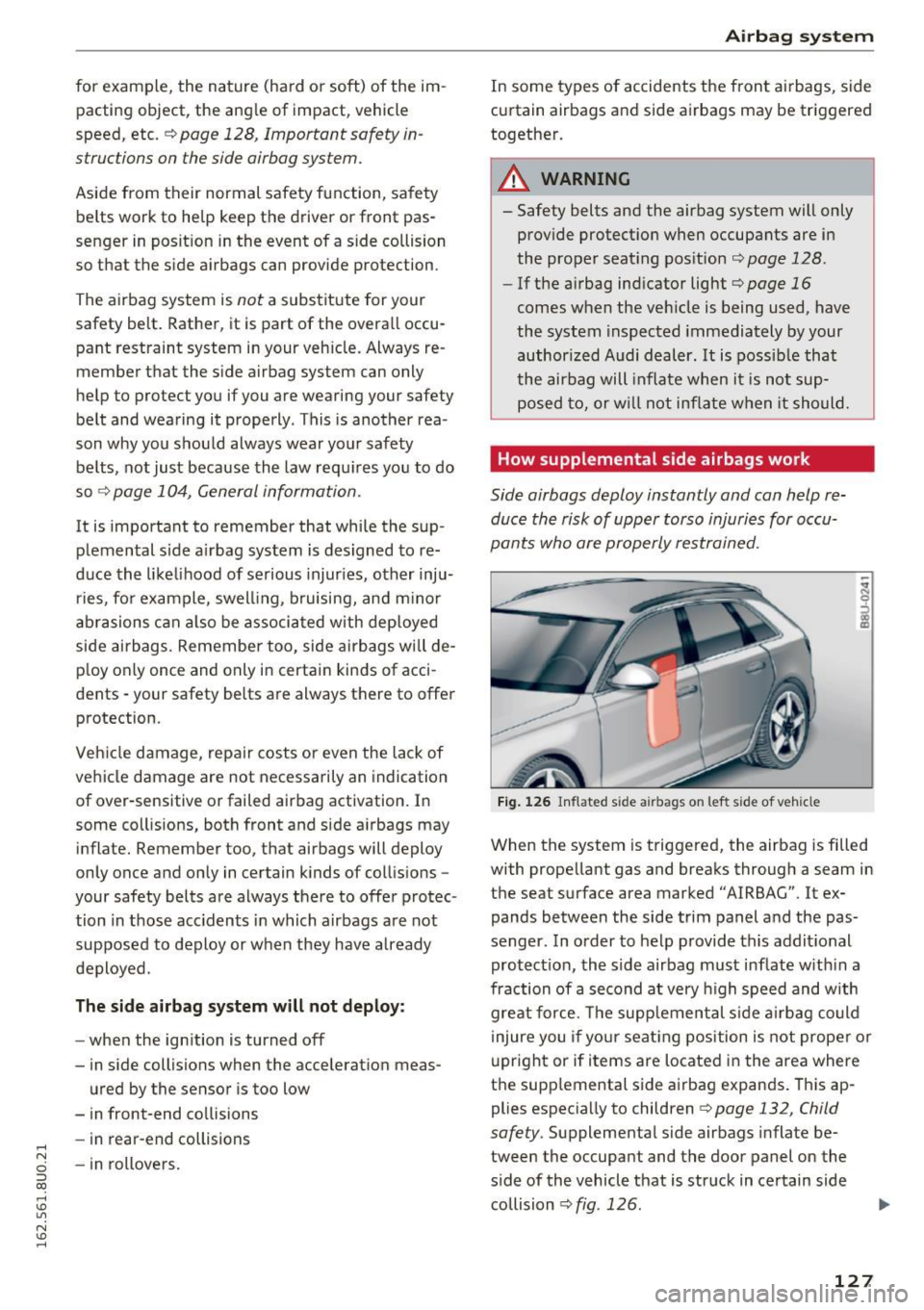
.... N
c:i ::J CX)
.... I.Cl U"I
N I.Cl ......
for example, the nature (hard or soft) of the im
pacting object, the angle of impact, vehicle
speed, etc.
¢ page 128, Important safety in
structions on the side airbag system.
Aside from their normal safety function, safety
be lts work to he lp keep the driver or front pas
senger in posit ion in the event of a side collision
so that the side airbags can provide protection.
The airbag system is
not a substitute for your
safety belt. Rather, it is part of the overall occu
pant restraint system in your veh icle. Always re
member that the side airbag system can only
help to protect you if you are wearing your safety
belt and wearing it properly . This is another rea
son why you should always wear your safety be lts, not just because the law requires you to do
so
¢ page 104, General information.
It is important to remember that while the sup
p lem ental side airbag system is designed to re
duce the likelihood of serious injur ies, other inju
ries , fo r example, swell ing, bruising, and minor
abrasions can also be associated with deployed
side airbags. Remember too, side airbags wi ll de
ploy only once and only in certain kinds of acci
dents· your safety belts are always there to offer
protection.
Vehicle damage, repair costs or even the lack of
ve hicl e damage are not necessarily an indication
of over-sensitive or failed airbag activation. In
some col lisions, both front and side a irbags may
inflate. Remember too, that airbags will deploy
only once and only in certain kinds of coll isions -
your safety belts are always there to offer protec ·
tion in those acc idents in which a irbags are not
supposed to deploy or when they have already
deployed.
The side airbag system will not deploy:
-when the ign ition is turned off
- in side collisions when the acceleration meas-
ured by the sensor is too low
- in front-end collisions
- in rear-end collisions
- in rollovers.
Airbag system
In some types of accidents the front airbags, side
curtain airbags and side airbags may be triggered
together.
A WARNING
=
- Safety belts and the airbag system will only
provide protection when occupants are in
the proper seat ing pos ition¢
page 128.
- If the airbag ind icator light Q page 16
comes when the veh icle is being used, have
the system inspected immediately by your
author ized Audi dealer. It is possible that
the airbag will inflate when it is not sup
posed to, or will not inflate when it should.
How supplemental side airbags work
Side airbags deploy instantly and can help re·
duce the risk of upper torso injuries for occu
pants who are properly restrained.
Fig. 126 Inflated side a irbags on left side of vehicle
When the system is triggered, the airbag is filled
with propellant gas and breaks through a seam in
the seat surface area marked "AIRB AG". It ex
pands between the side trim panel and the pas·
senger . In order to help provide this addit ional
protect ion, the side airbag must inflate w ith in a
fraction of a second at very high speed and with
great force. Th e supplemental side airbag could
injure you if you r seating position is not proper or
upright or if items are located in the area where
the supp lemental side a irbag expands. This ap
plies especially to children¢
page 132, Child
safety.
Supplemental side airbags inflate be
tween the occupant and the door panel on the
s ide of the vehicle that is struck in certain side
collision ¢
fig. 126. .,.
127
Page 131 of 252
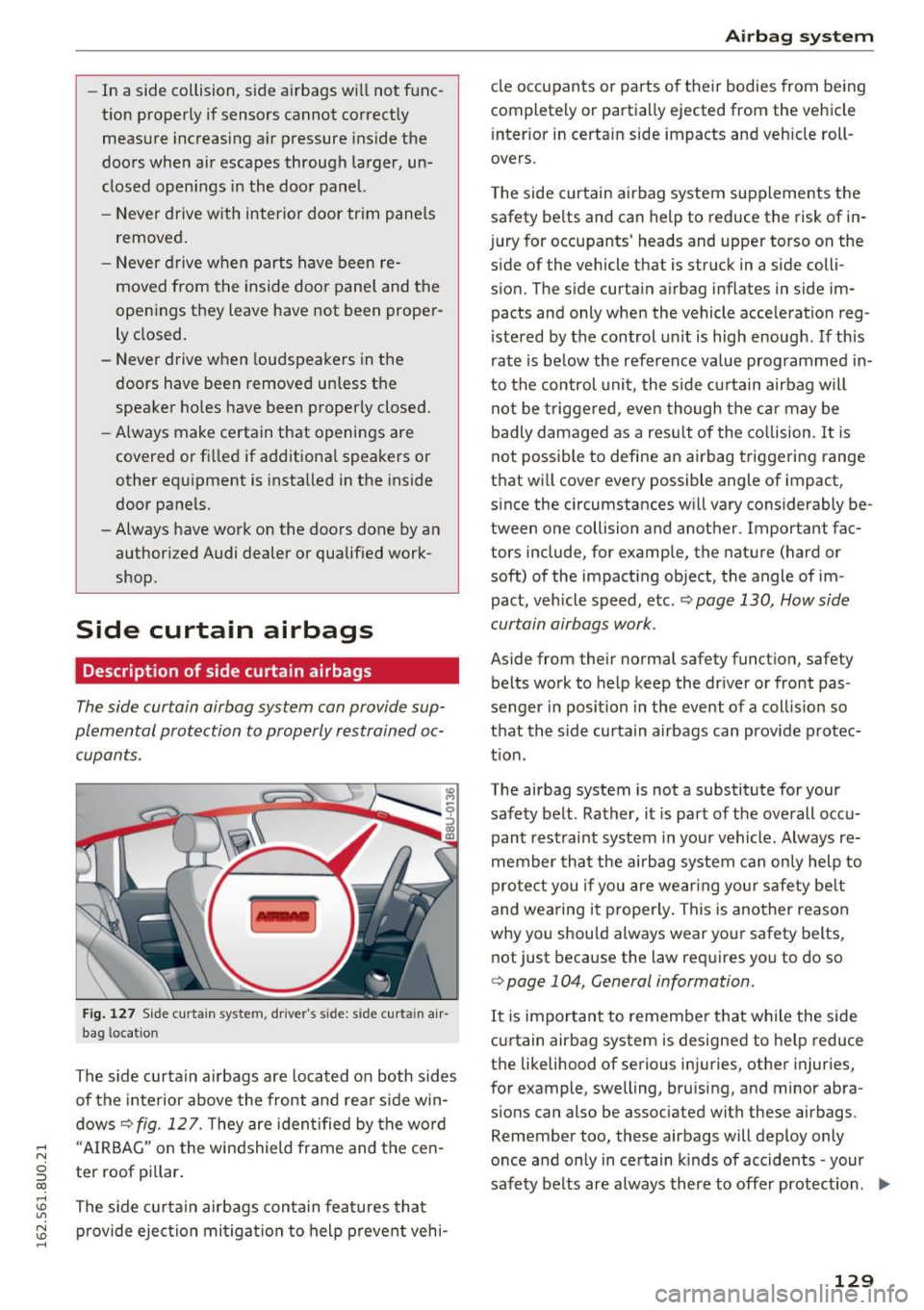
.... N
c:i ::J CX)
.... I.Cl U"I
N I.Cl ......
-In a side collision, side airbags will not func
tion properly if sensors cannot correctly
measure increasing a ir pressure inside the
doors when air escapes through larger, un
closed openings in the door panel.
- Never drive w ith inter ior door trim pane ls
removed.
- Never drive when parts have been re
moved from the inside door panel and the
openings they leave have not been proper ly closed.
- Never drive when loudspeakers in the doors have been removed un less the
speaker holes have been properly closed.
- Always make certain that openings are
covered or fi lled if additional speakers or
other eq uipment is installed in the inside
door panels.
- Always have work on the doors done by an
author ized Audi dealer or qualif ied work
shop.
Side curtain airbags
Description of side curtain airbags
The side curtain airbag system can provide sup
plemental protection to properly restrained oc
cupants.
F ig . 127 S ide curtain sys te m , dr iver's side: s ide c urta in air
bag locat ion
The s ide curtain airbags are located on both sides
of the interior above the front and rear s ide win
dows
Q fig. 127 . They are iden tified by the wo rd
"AIRBAG" on the w indshield frame and the ce n
ter roof pillar.
The s ide curta in airbags contain features that
p rovide ejec tion mi tiga tion to help p reve nt veh i-
Airb ag sys tem
cle occupants or par ts of their bodies from being
completely or partially ejected from the vehicle
i nterior in certain side impacts and veh icle roll
overs .
T he side curtain airbag system supplements the
safety belts and can help to reduce the risk of in
j ury for occupants' heads and upper torso on the
s ide of the vehicle that is struck in a side colli
sion. The s ide curtain airbag inflates in side im
pacts and only when the vehicle acce leration reg
istered by t he control unit is high enough . If this
rate is be low the reference va lue programmed in
to the control unit, the side cu rtain airbag will
not be t riggered, even though the ca r may be
badly damaged as a resu lt of the co llision . It is
not possible to define an airbag triggering range
that wi ll cover every possible angle of impact,
s ince the circumstances will vary considerably be
tween one collision and another. Important fac
tors include, for example, the nature (hard or
soft) of the impact ing object, the angle of im
pact, vehicle speed, etc .
Q page 130, How side
curtain airbags work.
Aside from their normal safety funct ion, safety
belts work to help keep the drive r or front pas
senger in position in the event of a coll is ion so
that the s ide curtain a irbags can prov ide p rotec
t ion.
The airbag system is not a substit ute for your
safety belt. Rather, it is part of the overall occ u
pant restraint system in your vehicle. Always re
member tha t the ai rbag system can on ly help to
pro tec t you if you are wear ing you r sa fety be lt
and wearing it properly . This is another reason
why you shou ld always wear yo ur safety belts,
not just because the law req uires you to do so
Q page 104, General information.
It is important to remember that while the side
cu rtain airbag system is designed to help reduce
the likelihood of serio us injuries, other injuries,
for example, swelling, bru ising, and minor abra
s ions can also be assoc iated with these airbags .
Remember too, these airbags will deploy only
once and on ly in ce rtain k inds of accidents -your
safety belts are always there to offer protec tion. ..,.
129
Page 132 of 252
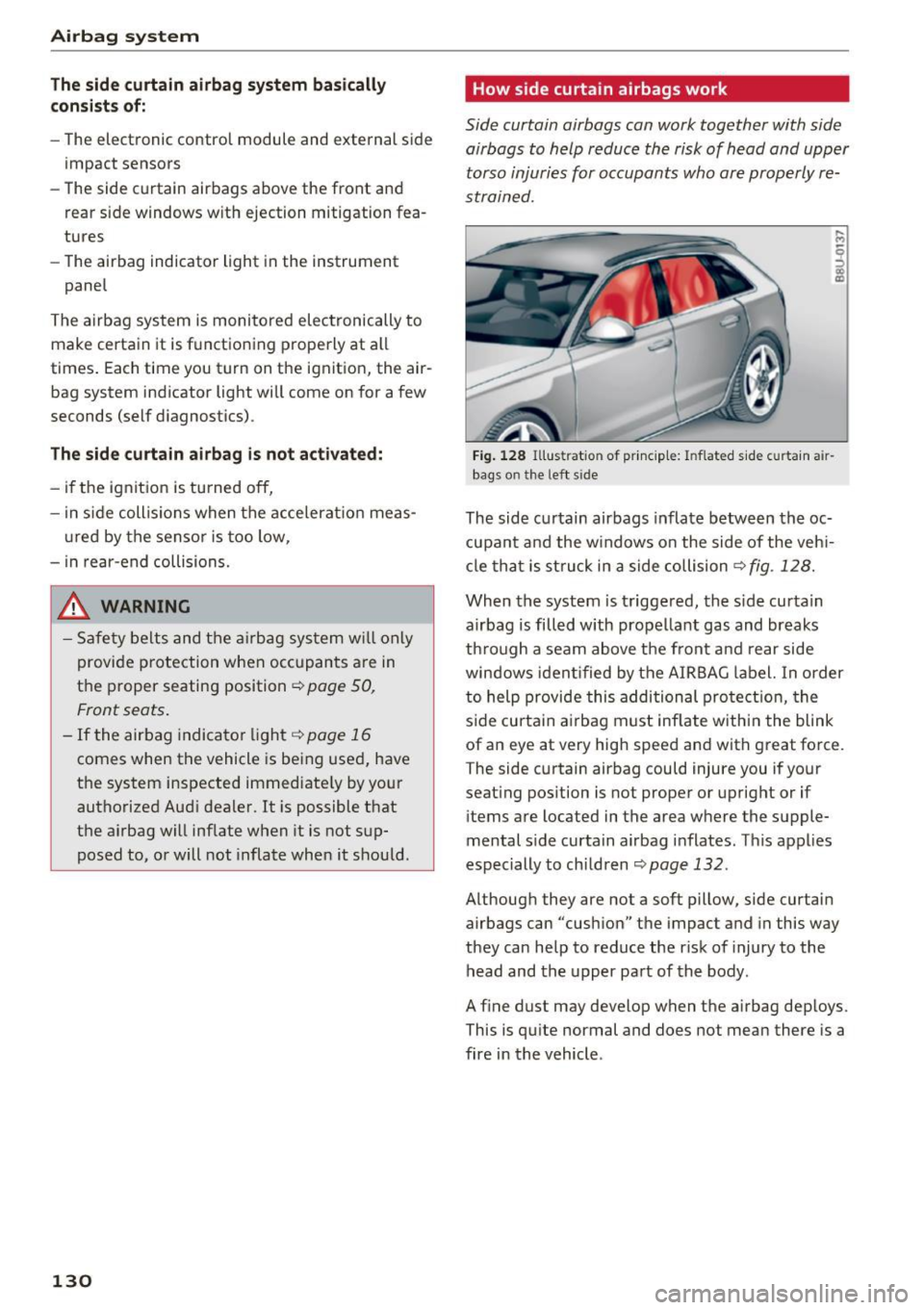
Airbag system
The side curtain airbag system basically
consists of:
- The electronic control module and external side
impact sensors
- The side curta in airbags above the front and
rear side windows with ejection mitigation fea
tures
- The airbag indicator light in the instrument
panel
The airbag system is monitored electronically to
make certain it is functioning properly at all
times. Each time you turn on the ignition, the air
bag system indicator light will come on for a few
seconds (self diagnostics).
The side curtain airbag is not activated:
-if the ignition is turned off,
-in side collisions when the acceleration meas-
ured by the sensor is too low,
- in rear-end collisions.
,&. WARNING
-Safety belts and the airbag system will only
provide protection when occupants are in
the proper seating position
¢ page 50,
Front seats.
-If the airbag indicator light ¢page 16
comes when the vehicle is being used, have
the system inspected immediately by your
authorized Audi dealer . It is possible that
the airbag will inflate when it is not sup
posed to, or will not inflate when it should.
130
How side curtain airbags work
Side curtain airbags can work together with side
airbags to help reduce the risk of head and upper
torso injuries for occupants who are properly re
strained.
Fig. 128 Illus tratio n of principle: I nflated side curtain a ir
bag s on t he left s ide
The side curtain airbags inflate between the oc
cupant and the windows on the side of the vehi
cle that is struck in a side collision
~ fig. 128.
When the system is triggered, the side curtain
airbag is filled with propellant gas and breaks
through a seam above the front and rear side
windows identified by the AIRBAG label. In order
to help provide this additional protection, the
side curtain airbag must inflate within the blink
of an eye at very high speed and with great force.
The side curtain airbag could injure you if your
seating position is not proper or upright or if
items are located in the area where the supple
mental side curtain airbag inflates. This applies
especially to children~
page 132.
Although they are not a soft pillow, side curtain
airbags can "cushion" the impact and in this way
they can help to reduce the risk of injury to the
head and the upper part of the body.
A fine dust may develop when the airbag deploys .
This is quite normal and does not mean there is a
fire in the vehicle .
Page 135 of 252
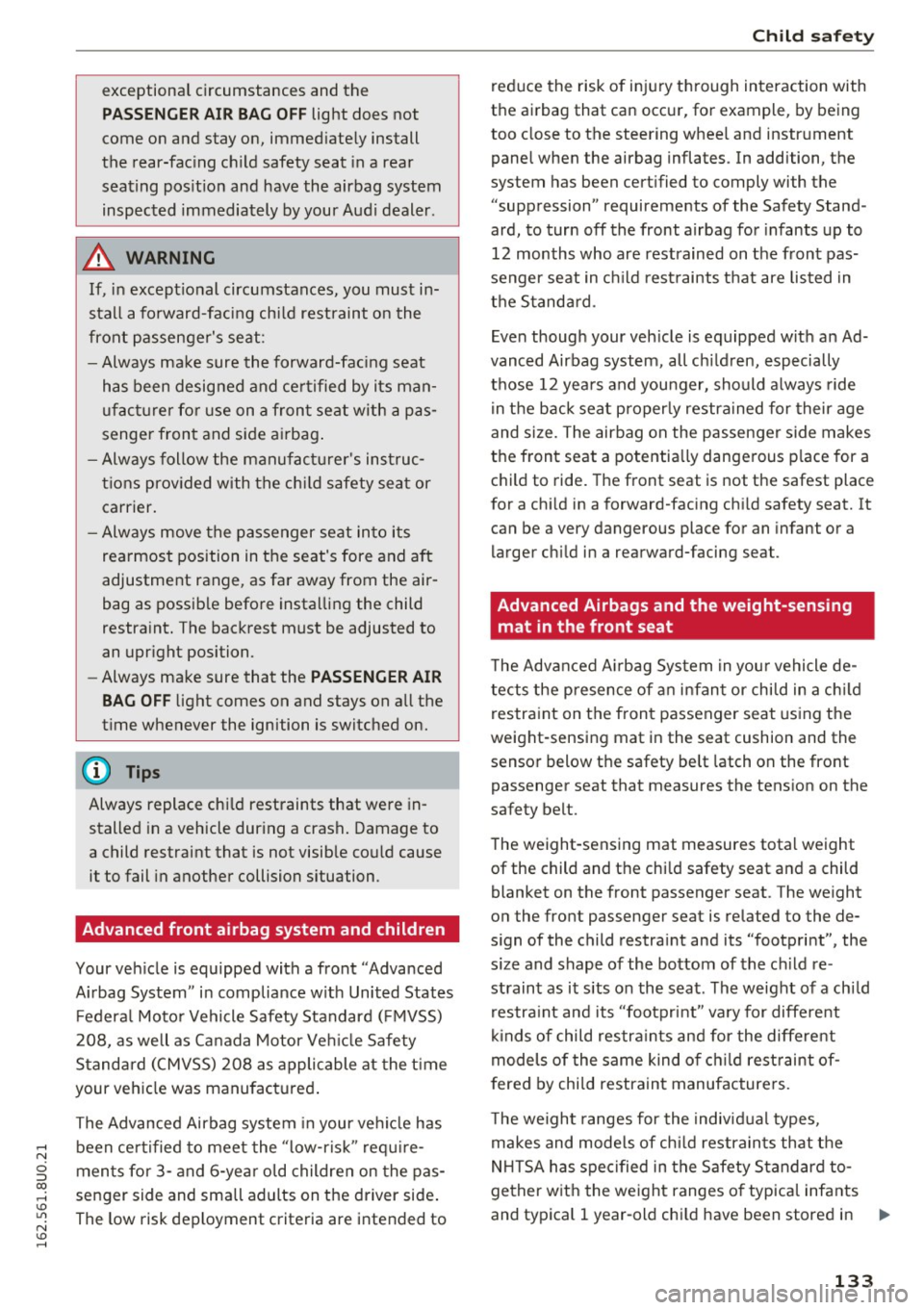
exceptional circumstances and the
PASS ENGER AIR BAG OFF light does not
come on and stay on, immed iately install
the rear-fac ing ch ild safety seat in a rear
seating pos it ion and have the airbag system
inspected immediately by your Audi dealer .
A WARNING
If, in exceptio nal circumstances, you must in
stall a forward-facing chi ld restraint on the
front passenger's seat:
- Always make sure the forward-fac ing seat
has been designed and ce rtified by its man
ufact urer fo r use on a front seat with a pas
senger front and side airbag .
- Always follow the manufact urer's instruc
tions prov ided with the ch ild safety seat or
carrier.
- Always move the passenger seat into its
rearmost position in the seat's fore and aft
adjustment range, as far away from the air
bag as possib le before installing the child
restraint. The backrest must be adjusted to
an upr ight position.
- Always make sure that the
PA SSENGER AIR
BAG OFF
light comes on and stays on all the
t ime whenever the ignition is switched on.
{D) Tips
Always replace chi ld restraints that were in
stalled in a vehicle dur ing a crash . Damage to
a child restraint that is not visible could cause
it to fail in another collision situation.
Advanced front airbag system and children
Your veh icle is equipped with a front "Advanced
Airbag System " in compliance w ith United States
F edera l Moto r Vehicle Safety Standard (FMVSS)
208, as well as Canada Motor Ve hicle Safe ty
Stand ard (CMVSS) 208 as appli cable at the t ime
your vehicle was manufactured .
The Advanced Airbag system in your ve hicle has
been ce rtified to meet the "low-risk " requ ire
ments for 3 -and 6-year old children on the pas
senger side and small adults on the driver side .
The low risk deployment criteria are intended to
Ch ild safety
reduce the risk of injury through interaction with
the airbag that can occur, for example, by being
too close to the steering wheel and instr ument
panel when the airbag inflates. In addition, the
system has been cert ified to comply with the
"suppression" requirements of the Safety Stand
ard, to turn off the front airbag for infants up to
12 months who are restrained on the front pas
senger seat in ch ild rest raints that are lis ted in
the S tanda rd .
Even thoug h your veh icle is equipped with an Ad
vanced Airbag system, all ch ildren, especially
those 12 yea rs and younger, sho uld a lways ride
i n the back seat properly restra ined for their age
and size . The airbag on the passenger side makes
the front seat a potentia lly dangerous p lace for a
child to ride. The front seat is not the safest place
for a ch ild in a forward-fac ing ch ild safety seat. It
can be a very dangerous place for an infant or a
larger ch ild in a rearward-facing seat .
Advanced Airbags and the weight -sensing
mat in the front seat
T he Advanced A irbag System in you r vehicle de
tects the presence of a n in fan t or child in a ch ild
restra int on the front passenger seat using the
weight-sensing mat in the seat cushion and the sensor below the safety belt latch on the front
passenger seat that measures the tension on the
safety belt.
The weight-sensing mat measures total weight
of the child and the chi ld safety seat and a child
blanket on the front passenger seat. The weight
on the front passenger seat is related to the de
s ign of the child restra int and its "footprint" , the
s ize and shape of the bottom of the c hild re
straint as it s its on the seat. The weight of a chi ld
r estra int and its "footprint " va ry for different
k inds of child restra ints and for the different
models of the same kind of ch ild rest raint of
fered by child restraint manufacturers.
T he weight ranges for the individ ual types,
makes and mode ls of chi ld restrain ts that the
N HT SA has spec ified in the Safety Standard to
gether with the weight ranges o f typical infants
and typical 1 year-old chi ld have been stored in .,.
133
Page 136 of 252
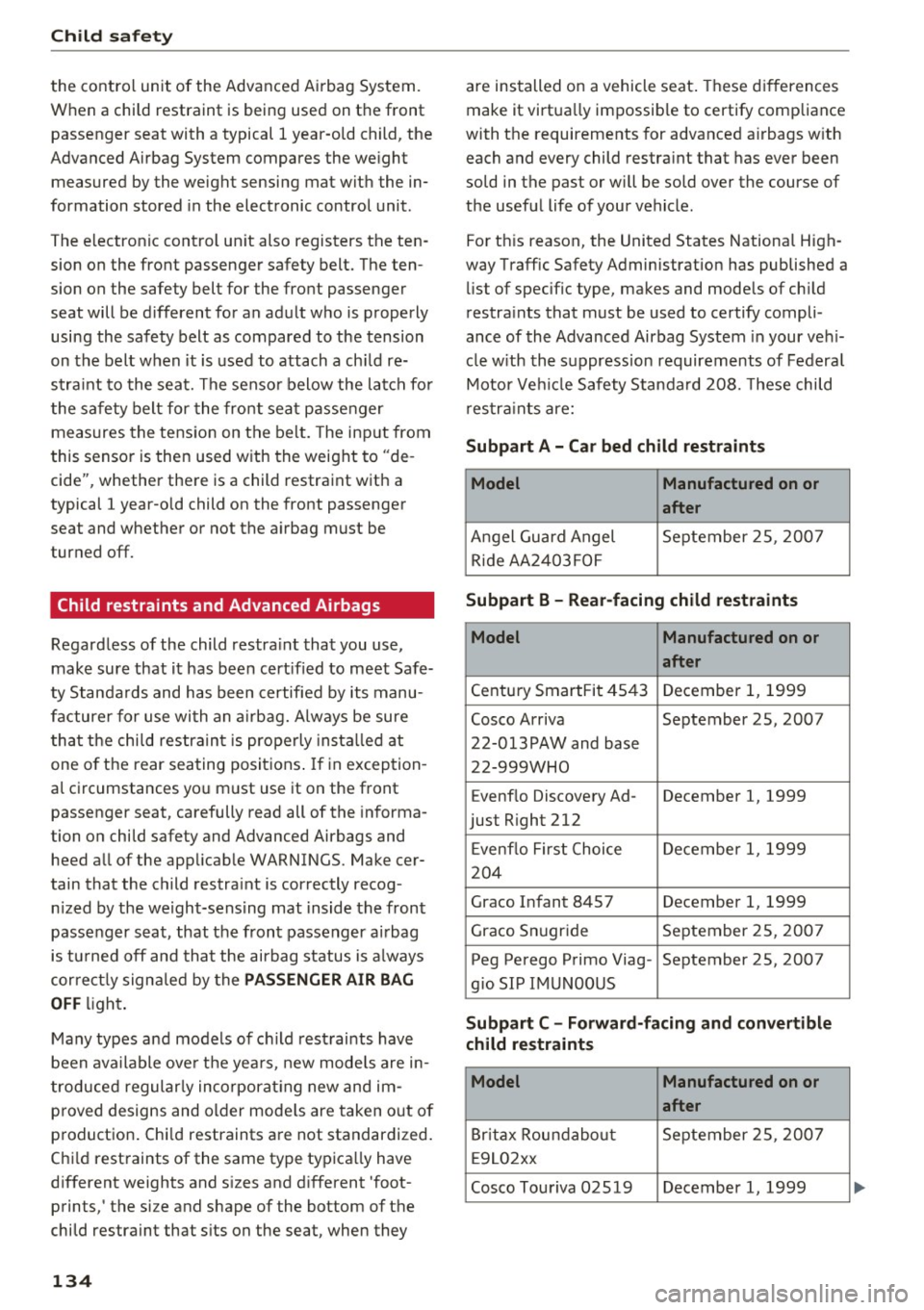
Child safet y
the control unit of the Advanced Ai rbag System.
When a chi ld restraint is being used on the front
passenger seat with a typical 1 year-old child, the
Advanced Airbag System compares the we ight
measured by the weight sensing mat with the in
formation stored in the electronic control unit.
The electronic cont rol un it also registers the ten
sion on the front passenger safety belt. The ten
sion on the safety belt for the front passenger
seat will be d ifferent fo r an adult who is properly
using the safety belt as compared to the tension
on the belt when it is used to attach a ch ild re
stra int to the seat. The senso r below the la tch fo r
the safety belt for the fro nt sea t passe nger
meas ures the tens io n on the belt. The inp ut from
this sensor is then used with the weight to "de
cide", whether there is a child restraint with a
typical 1 year-old child on the front passenger
seat and whethe r or not the a irbag must be
turned off.
Child restraints and Advanced Airbags
Regardless of the child restra int tha t you use,
make sure that it has been cert ified to meet Safe
ty Standa rds and has been certified by its manu
facturer for u se wi th an a irb ag. Always be sure
t ha t th e chi ld res tra in t i s properly insta lled at
one o f th e rear seating posit ions . If i n excep tion
a l ci rcumstances yo u must use it on the front
passenger seat, carefully read all of the informa
tion on child safety and Advanced Airbags and heed a ll of the app licab le WARNINGS. Make cer
tain that the child restra int is correctly recog
n ized by the we ight-sens ing mat inside the front
passenger seat, that t he fron t passenger a irbag
is tu rned off and tha t the airbag status is a lways
cor rect ly signa led by the
PASSENGER AIR BAG
OFF ligh t.
M any types and models of c hild rest rai nts have
been available ove r th e yea rs, new models are in
t roduced regularly incorporat ing new and im
p roved designs and o lder mode ls are taken o ut o f
p roduction . Chi ld restraints a re not standardized .
Ch ild rest raints of the same type typica lly have
d ifferent weights and s izes and d ifferent 'foot
prints, ' the size and shape of the bottom of the
chi ld restraint that s its on the seat, when they
134 are ins
talled on a vehicle seat . These d ifferences
make it virtua lly impossib le to certify compliance
with the requirements for advanced a irbags w ith
each and every child restra int that has eve r been
sold in the past or will be so ld over the course of
the usefu l life of your vehicle.
Fo r thi s reason, the United States Nationa l H igh
way Traffic Safety Administration has published a li st of specific type, makes and mode ls of ch ild
r estra ints that must be used to certify compli
ance of the Advanced Airbag System in your ve hi
cle w ith the s uppress ion requirements of Federa l
Motor Ve hicl e Safety Standa rd 208. These child
r es trai nts are:
Subpart A - Car bed child restraints
Model Manufactured on or
after
Angel Guard Angel Septe mber 25, 2 007
R ide AA2 403FO F
Subpart B - Rear-facing child restraints
Model Manufactured on or
after
Cent ury SmartFi t 454 3 Decembe r 1, 1999
Cosco Arriva September 25, 2007
22-013PAW and base
22- 999WHO
Evenf lo Discove ry Ad -December 1, 1999
just R ight 212
E venflo First Choi ce Decembe r 1, 1999
2 04
Graco I nfant 8457 December 1, 1999
Graco Snugr ide September 25, 20 07
Peg Perego Primo Viag- September 25, 2007
g io SIP I MUNOOUS
Subpart C -Forward-facing and convertible
child restraints
Model Manufactured on or
after
B rit a x Roun dabo ut September 25, 200 7
E 9 L02xx
Cosco Touriva 02519 December 1, 1999
Page 170 of 252
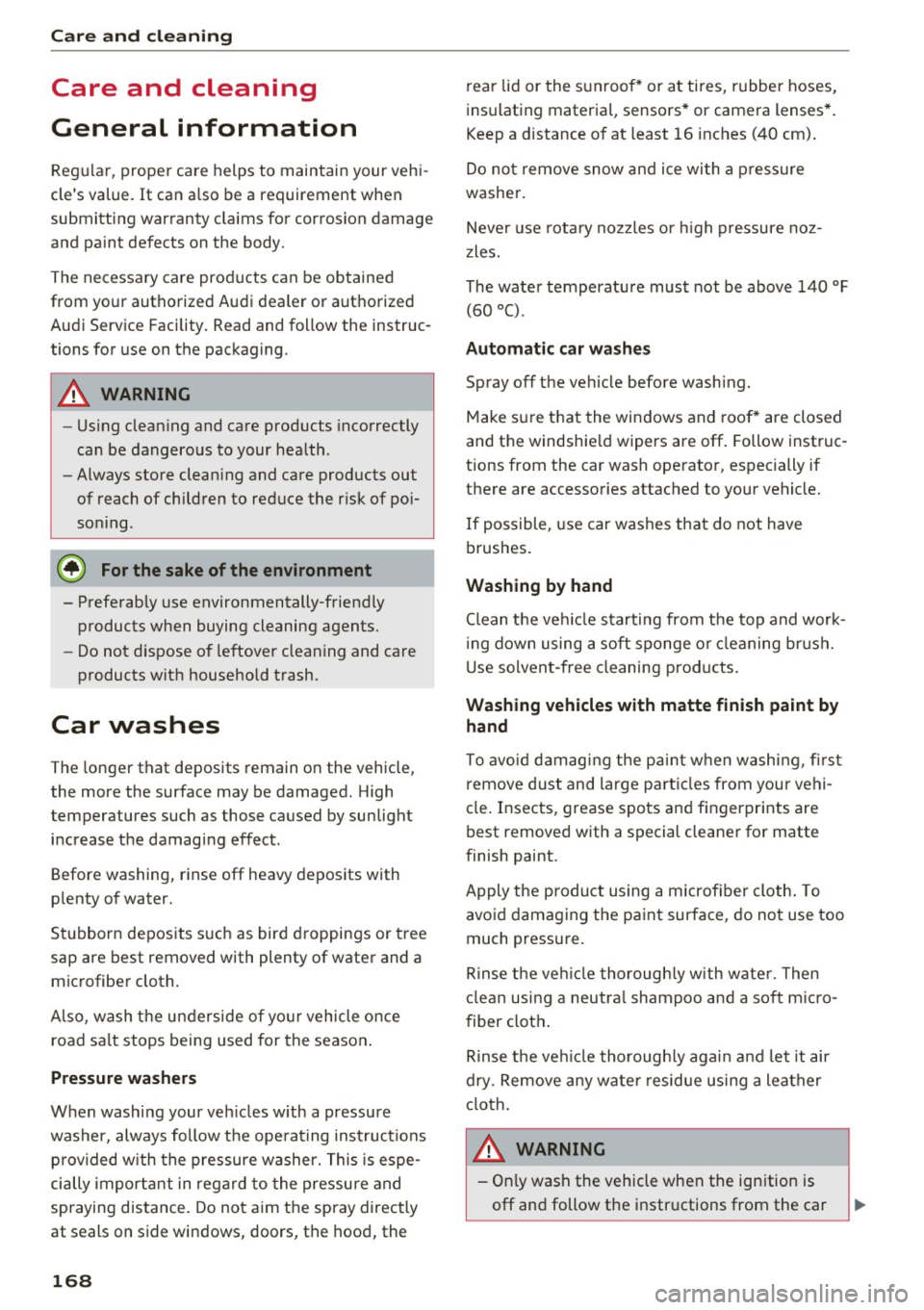
Care and cleaning
Care and cleaning
General information
Regular, prope r care helps to maintain your vehi
cle's value.
It can a lso be a requirement when
submitting war ranty claims for cor rosion damage
and pa int defects on the body.
The necessary care prod ucts can be obtained
from your authorized Audi dealer o r authorized
Aud i Service Facility. Read and follow the instruc
tions for use on the packaging.
A WARNING
- Using cleaning and care products incorrectly
can be dangero us to your hea lth .
- Always store clean ing and care products out
of reach of children to reduce the r isk of po i
so ning .
@ For the sake of the environment
- Preferab ly use environmentally-friendly
products when buying cleaning agents.
- Do not dispose of leftove r clean ing and care
products wit h household t rash.
Car washes
The longer that deposits remain on the veh icle,
the more the surface may be damaged. High
temperatures such as those caused by sunlight
increase the damaging effect.
Before washing, rinse
off heavy deposits with
p lenty of water.
Stubborn deposits s uch as bird droppings or tree
sap are best removed with plenty of water and a mic rofibe r cloth.
A lso, wash the underside of yo ur vehicle once
road sa lt stops being used for the season .
Pressure washers
When washing your veh icles with a pressure
washer, always follow t he ope ra ti ng inst ructions
p rovided w ith the pressure washer. This is espe
cially important in regard to the pressure and
spraying distance . Do not a im the spray directly
at seals on side windows, doors, the hood, the
168
rear lid or the sunroo f* or at tires rubber hoses I I
insulating material, sensors* or camera lenses* .
Keep a distance of at least 16 inches (40 cm) .
Do no t remove snow and ice with a pressure
washe r.
Neve r use rota ry no zzles or high pressure noz
z les.
The water temperatu re must not be above 140 °F
(60 °().
Automatic car washes
Spray
off the vehicle before washing.
Make su re that the windows and roof * are closed
and t he windshie ld wipers are
off . Follow instruc
tions from the car wash operato r, especially if
there are accessories attached to your vehicle.
If possible, use car washes that do not have
brushes.
Washing
by hand
Clean the vehicl e starting from the top and work
in g down using a soft sponge or cleaning br ush .
Use solvent-free cleaning products.
Washing vehicles with matte finish paint
by
hand
To avo id damaging the paint w hen washing, fi rst
remove dust and large pa rt icl es from your vehi
cle. Insects, grease spots and fingerprints are
best removed with a special cleane r for matte
finish paint .
Apply the p rodu ct using a microfiber cloth. To
avoid damaging the paint surface, do not use too
much pressure.
Rinse the vehicle thorough ly w ith wate r. Then
clean using a neutra l shampoo and a soft m icr o
fiber cloth .
R inse the ve hicle thorough ly again a nd let it air
dry. Remove any water residue using a leather
cloth.
A WARNING
- Only wash the vehicle when the ignition is
off and follow the instr uctions from the car
-
Page 171 of 252
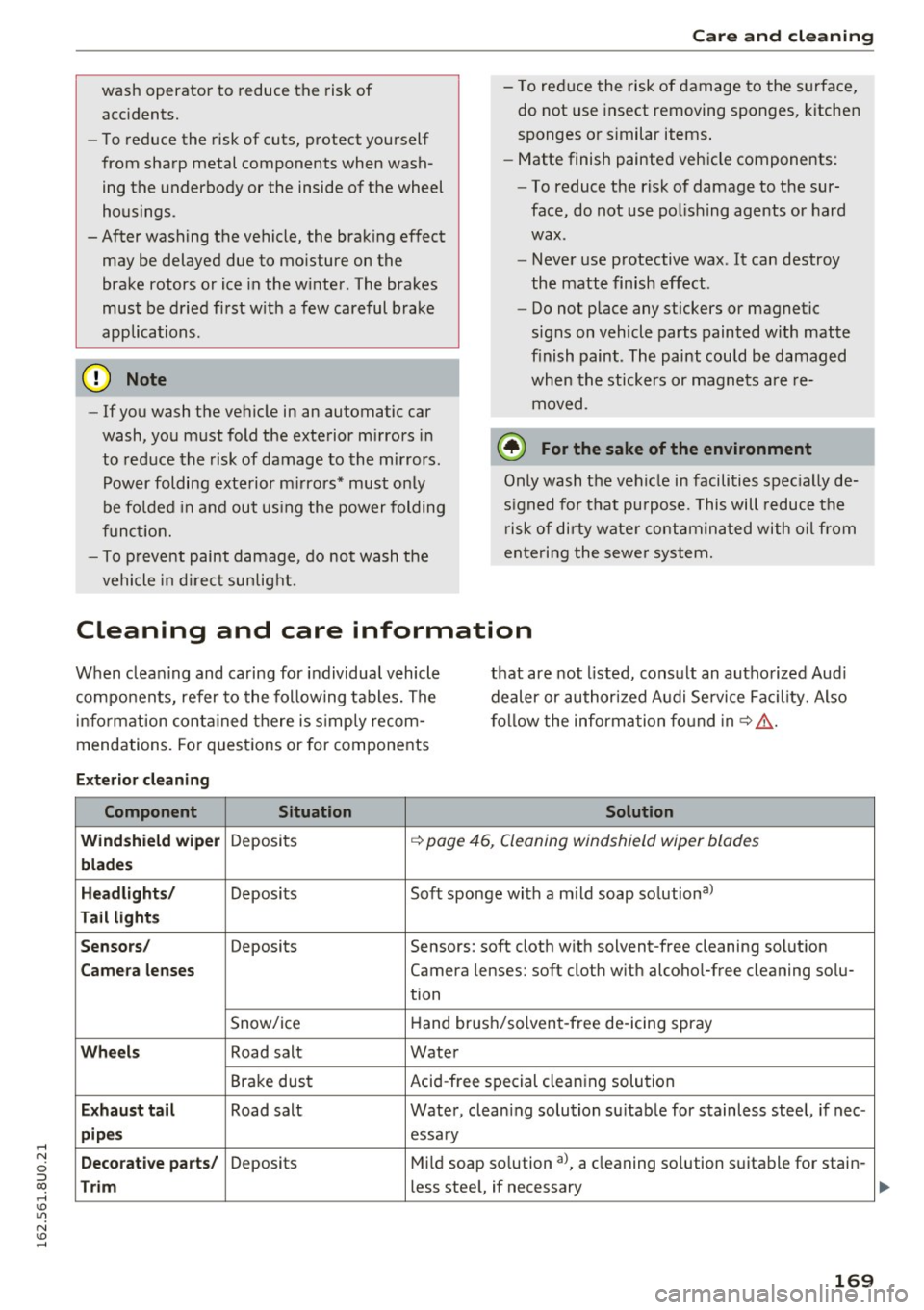
wash operator to reduce the risk of acc idents.
- To reduce the risk of cuts, protect yourself
from sharp metal components when wash
ing the underbody or the inside of the wheel
housings .
- After washing the vehicle, the brak ing effect
may be delayed due to mo isture on the
brake rotors or ice in the w inter . The brakes
must be dried first w ith a few careful brake
applica tions .
- If you wash the vehicle in an automatic car
wash, yo u m ust fold the exterior m irrors i n
to reduce the risk of damage to the mirrors.
Power folding exte rior m irrors* must on ly
be fo lded in a nd out using the power folding
funct ion.
- To p revent paint damage, do not wash the
vehicle i n direct sunlight.
Ca re and cleaning
- To re duce the risk of damage to the surface,
do not use insect removing sponges, kitchen
sponges or s imilar items .
- Matte finish painted veh icle components:
- To reduce the risk of damage to the sur-
face, do not use po lishing agents or hard
wax.
- Never use protective wax. It can destroy
the matte finish effect .
- Do not place any stickers or magnetic
signs on vehicle parts painted with matte
finish paint. The paint cou ld be damaged
when the stickers or magnets are re
moved .
@ For the sake of the environment
Only wash the vehicle in facili ties s pec ia lly de
s igned for that pu rpose. This will reduce the
r isk of dir ty wate r contam ina ted with o il from
en te ring the sewe r sys tem.
Cleaning and care information
W hen clea ning and ca ring for individua l vehicle
components, refer to the following tables. The
in fo rmation co ntai ned there is s imp ly recom
mend ations. For quest ions or for components that are
not listed, cons ult an autho rized Aud i
dealer or author ized A udi Se rvice Fac il ity. Also
f o llow the information fo und in ~ .&. -
Ext erior cleaning
Component Situation Solution
Windshield wiper
Deposits ~ page 46, Cleaning windshield wiper blades
blades
H eadlights /
Deposits Soft sponge with a mild soap solutiona >
Tail light s
Sensors /
Deposits Sensors: soft cloth with solvent-free cleaning solution
Camera lenses Camera lenses: soft cloth w ith alcoho l-free cleaning solu-
tion
Snow/i ce H
and brus h/solven t-free de-icing spray
Whe els Road salt Water
Brake dust Acid
-free special clean ing solution
Exhaust tail Road salt Water, clean ing solution su itab le for stainless stee l, if nee -
pipes essary
Decorative parts/ Deposits M
ild soap so lution al, a cleaning so lution s uitable for stain-
Trim less stee l, if necessary
169
...